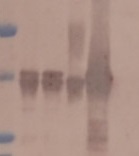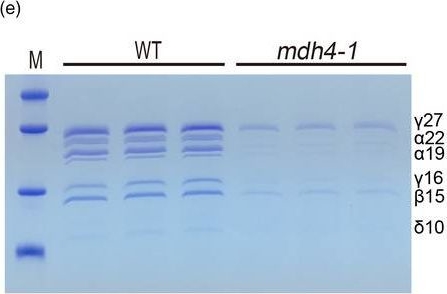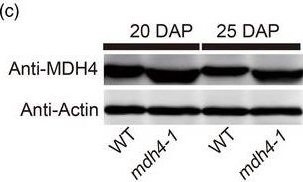1

Anti-MDH4 | Malate dehydrogenase 4 (cytoplasmic)
AS15 3065 | Clonality: Polyclonal | Host: Rabbit | Reactivity: Zea mays
- Product Info
-
Immunogen: Recombinant MDH4 of Zea mays, UniProt: Q08062
Host: Rabbit Clonality: Polyclonal Purity: Serum Format: Lyophilized Quantity: 50 µl Reconstitution: For reconstitution add 50 µl of sterile water Storage: Store lyophilized/reconstituted at -20°C; once reconstituted make aliquots to avoid repeated freeze-thaw cycles. Please remember to spin the tubes briefly prior to opening them to avoid any losses that might occur from material adhering to the cap or sides of the tube. Tested applications: Western blot (WB) Recommended dilution: 1 : 1000 (WB) Expected | apparent MW: 33.5 kDa - Reactivity
-
Confirmed reactivity: Zea mays Predicted reactivity: Arabidopsis thaliana, Brachypodium distachyon, Brassica oleracea, Capsella rubella, Catharanthus roseus, Erythranthe guttata, Glycine max, Gossypium hirsutum, Hordeum vulgare, Jatropha curcas, Malus domestica, Nicotiana tabacum, Oryza sativa, Prunus peersica, Ricinus communis, Setaria italica, Solanum lycopersicum, Solanum tuberosum, Sorghum bicolor, Triticum aestivum, Vitis vinifera
Species of your interest not listed? Contact us - Application Examples
-
Application example 
Zea mays crude extract (1), Zea mays mitochondria enriched fraction (2), immunoprecipitated sample (3), recombinant MHD4, expressed in E.coli (4). Total maize leaf proteins were extracted from 600 mg frozen leaf material with 1:4 ratio using 2.4 ml of extraction buffer (50 mM Trsi-HCl pH 8.0, 10 mM Ascorbate, 2 mM EDTA and 330 mM Mannitol, 1 x protease Inhibitor cocktail (Sigma Aldrich P8849-5ML). The homogenate was produced by mortar and pestle and centrifuged at 4000 x g for 10 min. at 4°C. The SDS-sample buffer (lane 1 in SDS-PAGE) is related to extraction using directly mortar and pestle and 2.4 ml of SDS-sampe buffer (0.1 M Tris-HCl pH 8.0, 100 mM DTT, 2 mM EDTA, 30% glycerol, 0.05 % bromophenolblue). The supernatant of 4000 x g was further centrifuged at 20,000 x g for 3 min in order to remove the chloroplasts. SDS-PAGE was performed using NuPAGE 4-12% (Invitrogen) at 120 V for 1.2 hours and blotted for 1h to Nitrocellulose membrane (BIOTrace NT, PALL, Life Sciences) using semi-dry transfer apparatus (Hoeffer) at 45 Ampere x 2 (gels) and variable voltage. Blots were blocked with Genscript 5M Quick Blocking solution (One step western blot kit, mix of solution A, casein hydrolysate and B, TTBS 1:1) for 15 minutes at room temperature (RT) with agitation. Blot was incubated in the primary antibody at a dilution of 1: 2 000 overnight at RT with agitation (sealed in a bag). The antibody solution was decanted and the blot was rinsed briefly twice with TTBS, then washed 3 times for 10 min in TTBS at RT with agitation. Blot was incubated in secondary antibody (anti-rabbit IgG horse radish peroxidase conjugated, diluted to 1:5000 in TTBS for 45 minutes at RT with agitation. The blot was washed as above and developed for 5 min with NBT/BCIP Ready-to-Use Tablets. Color development was stopped by decanting the solution and replacing with distilled water containing 10 mM EDTA. The membranes were dried on paper and photographed. Samples (boiled in boiling water for 10 minutes): 1) crude leaf extract by SDS-sample buffer (centrifuged 4000 x g for 10 min. at 4°C); Loaded 10µl 2) Leaf, mitochondria enriched supernatant 20,000 x g for 3 min. at 4°C; Loaded 10µl 3) Immunoprecipitation (IP) samples (tot. vol= 100µl); Loaded 8µl 4) Recombinant protein 1 µg/µl; loaded 1µl;
Courtesy of Dr. Giuseppe Dionisio, Aarhus University, Danmark
Application examples: 
Reactant: Zea mays (Maize/Corn)
Application: Western Blotting
Pudmed ID: 32436613
Journal: Plant Biotechnol J
Figure Number: 1E
Published Date: 2020-12-01
First Author: Chen, Y., Fu, Z., et al.
Impact Factor: 8.66
Open PublicationPhenotypic comparison between WT and the mdh4?1 mutant. (a) Segregation of Zheng58 × mdh4?1 F2 seeds. The red arrows indicate mdh4?1 kernels; scale bar, 1 cm. (b) 100?kernel weight of the WT vs. mdh4?1, with five replicates. (c) Comparison between the longitudinal sections of WT and mdh4?1 kernels. En, endosperm; Em, embryo; scale bar 2 mm. (d) Starch and amylose content in WT vs. mdh4?1 endosperms with four replicates. (e) Zein proteins in 12 DAP endosperms of WT and mdh4?1. (f) Total lysine content in WT vs. mdh4?1 mature kernels with three replicates. (g) Representative examples of germination of the WT and mdh4?1 seeds; scale bar, 1 cm. (h) Germination rate of WT vs. mdh4?1 with three replicates. (i) Radical length of WT vs.mdh4?1 seedlings with three replicates. (j) Representative examples of WT and mdh4?1 seedlings 13 days after germination (DAG); scale bar, 5 cm. (k) Height and root length of WT vs. mdh4?1 seedlings 13 DAG, with ten replicates. (l) Representative examples of mature WT and mdh4?1 plants; scale bar, 30 cm. (m) Plant height and ear length of mature WT vs. mdh4?1 plants, with 15 replicates. In all bar graphs, values are represented as means ± SE, **P < 0.01, ***P < 0.001 denote statistically significant differences between WT and mdh4?1 (Student's t?test).

Reactant: Zea mays (Maize/Corn)
Application: Western Blotting
Pudmed ID: 32436613
Journal: Plant Biotechnol J
Figure Number: 5A
Published Date: 2020-12-01
First Author: Chen, Y., Fu, Z., et al.
Impact Factor: 8.66
Open PublicationExpression pattern and subcellular localization of ZmMdh4. (a) Quantitative PCR analysis of ZmMdh4 relative transcript abundance in various tissues from WT vs. mdh4?1 mutant plants. Values are represented as means ± SE of three biological replicates. ***P < 0.001, t?test. (b) ZmMdh4 expression during endosperm development. (c) The abundance of ZmMDH4 protein in the WT vs. mdh4?1 mutant. (d) Subcellular localization of ZmMDH4 in Nicotiana benthamiana leaves and Arabidopsis mesophyll protoplasts; scale bars are 100 ?m.
- Additional Information
-
Additional information (application): Immunoprecipitation was performed by using Dynabeads ® Protein A: briefly 100 µl suspension was washed with 200 µl TTBS (Tris Buffered saline, 50 mM Tris-HCl pH 7.6 and 165 mM NaCl with 0.1% Tween 80) using the magnetic stands for concentrating the magnetic beads. After wash the beads were preincubated with 20 µl primary antibodies in 180 µl TTBS at room temperature for 30 minutes (minimum 15 minues). A first wash was followed afterwards with 200 µl TTBS and hence a real incubation with 200 µl plant extract (supernatant 20,000 x g for 3 min.), 200µl of TTBS and further 50 µl YeastBuster reagent (Novagen) containing a mixture of detergents to break and solubilize the mitochondria membrane. This incubation at room temperature was allowed to be under mild shaking to allow the beads to be in suspension. Hence supernatant was aspirated away by the use of the magnetic stand and two further washesing steps with 200 µl TTBS were performed prior mixing with 100 µl SDS-Sample buffer.
Antibody is also binding to recombinant MHD4 (see image below). - Background
-
Background: Malate dehydrogenase 4 (cytoplasmic), (EC:1.1.1.37) display catalytic activity in conversion of (S)-malate + NAD+ = oxaloacetate + NADH.
- Product Citations
-
Selected references: Lim et al (2022). Arabidopsis guard cell chloroplasts import cytosolic ATP for starch turnover and stomatal opening. Nat Commun. 2022 Feb 3;13(1):652. doi: 10.1038/s41467-022-28263-2. PMID: 35115512; PMCID: PMC8814037. - Reviews:
-
Boon Leong Lim | 2022-04-14We used this antibody to detect cytosolic NAD-MDH of Arabidopsis. The maize MDH antigen exhibits 92%
identity to the cytosolic NAD-MDH, 43% to the plastidic NAD-MDH, but no
homology to the mitochondrial or the peroxisomal NAD-MDH or NADP-MDH
from Arabidopsis. The resutl was published in Nature Communications.
https://www.nature.com/articles/s41467-022-28263-2
Accessories

AS04 054 | Clonality: Polyclonal | Host: Rabbit | Reactivity: A. thaliana, B. nana, B. napus, B. oleracea, B. vulgaris, E. vaginatum, H. vulgare, L. luteus, N.tabacum, O. sativa, P.abies, P. sativum, S.tuberosum and T. aestivum, conifers and P. patens cellular[compartment marker] of mitochondrial inner membrane
Benefits of using this antibody


